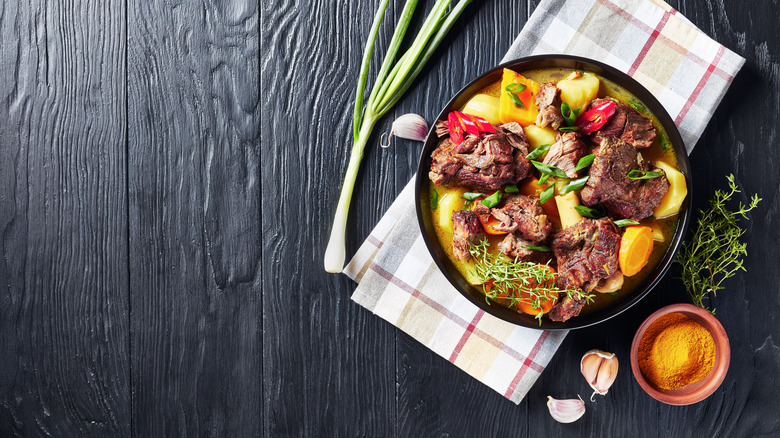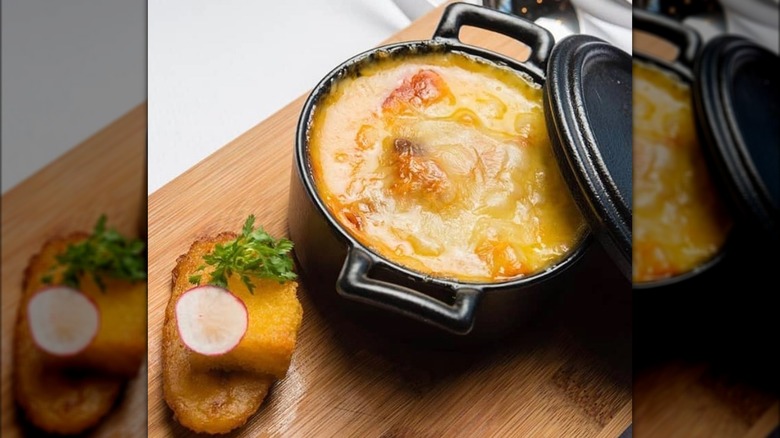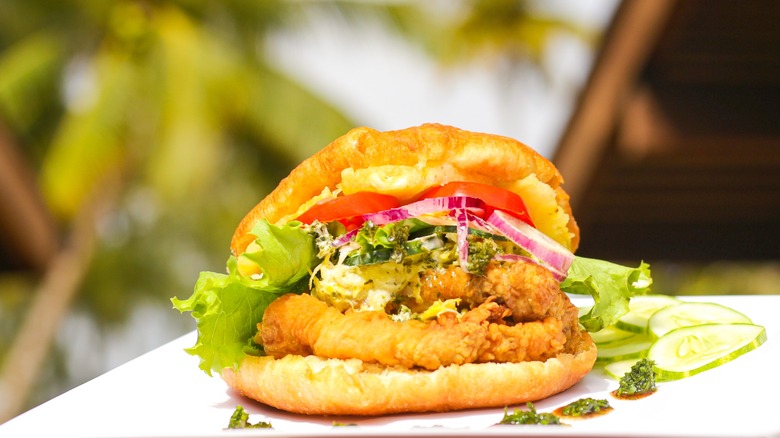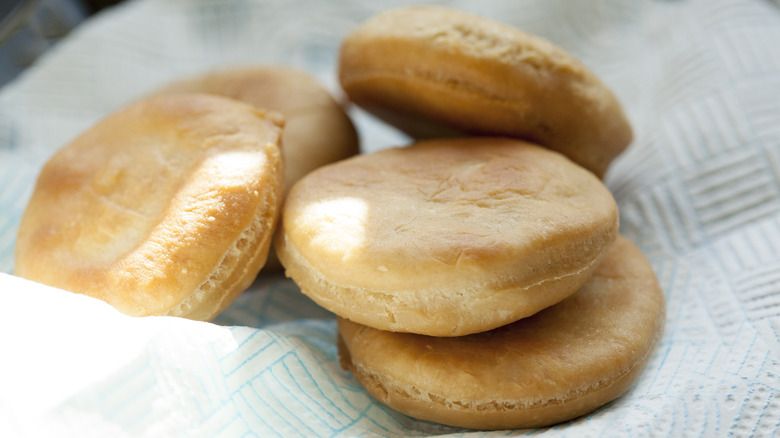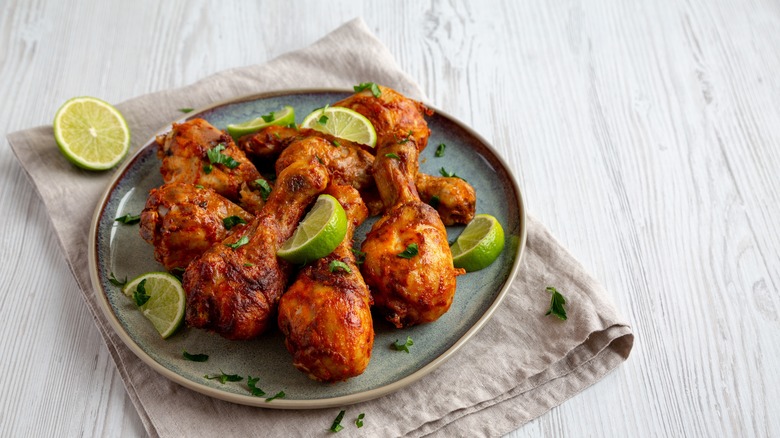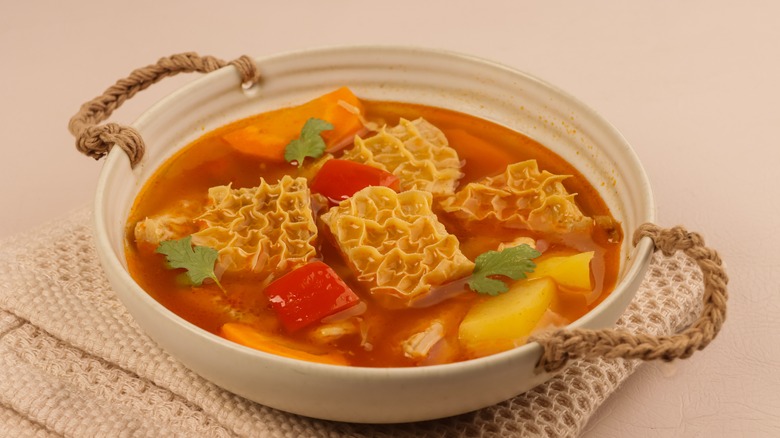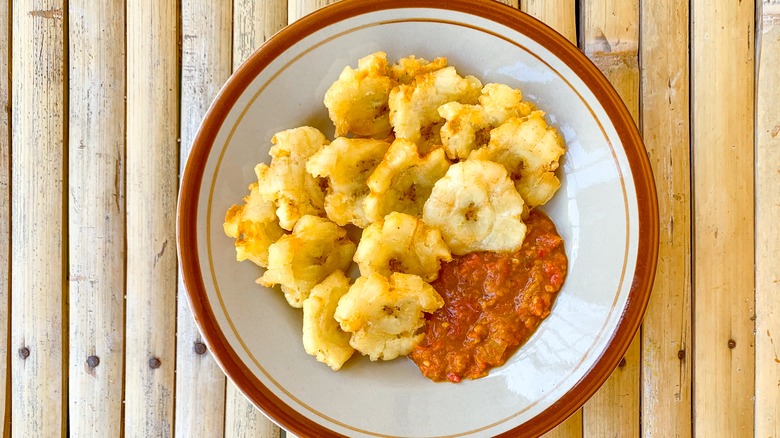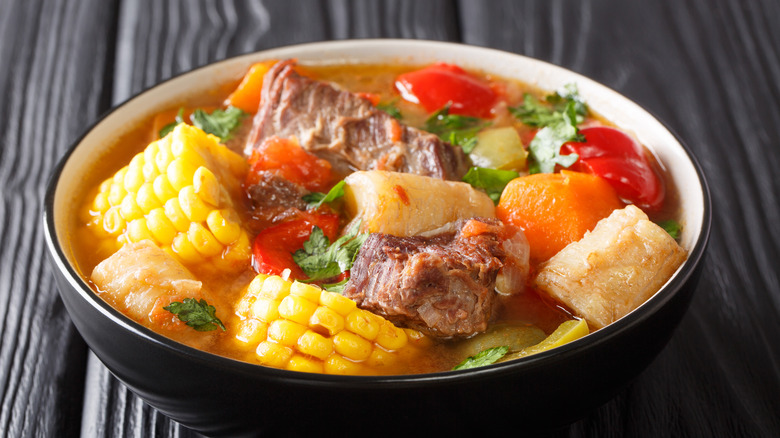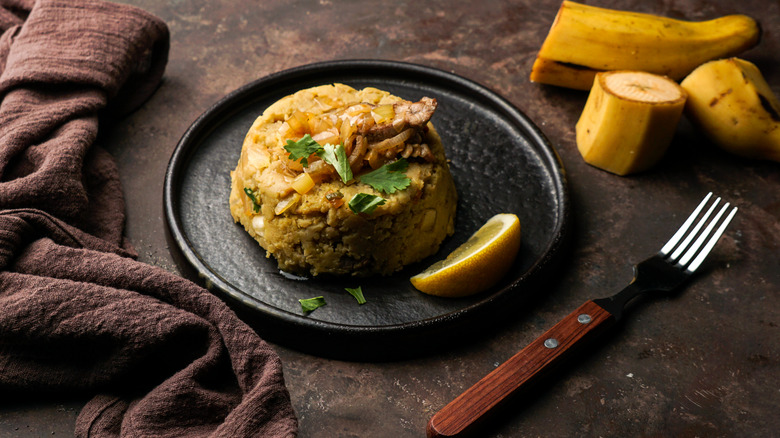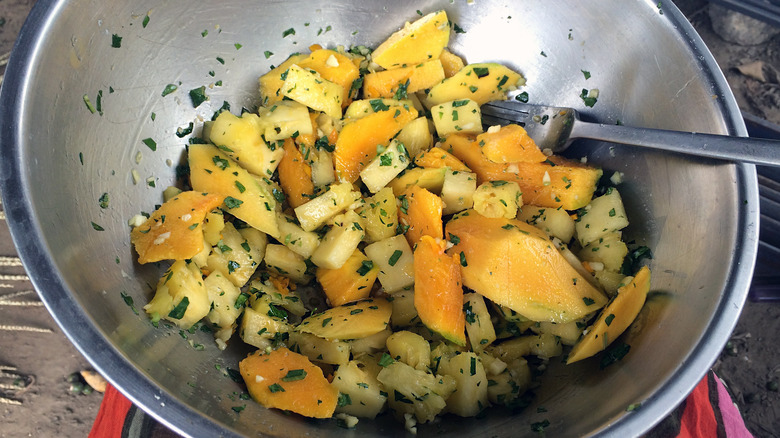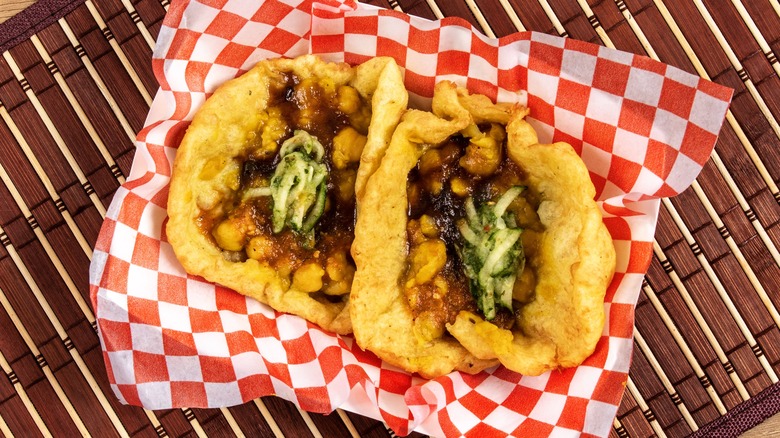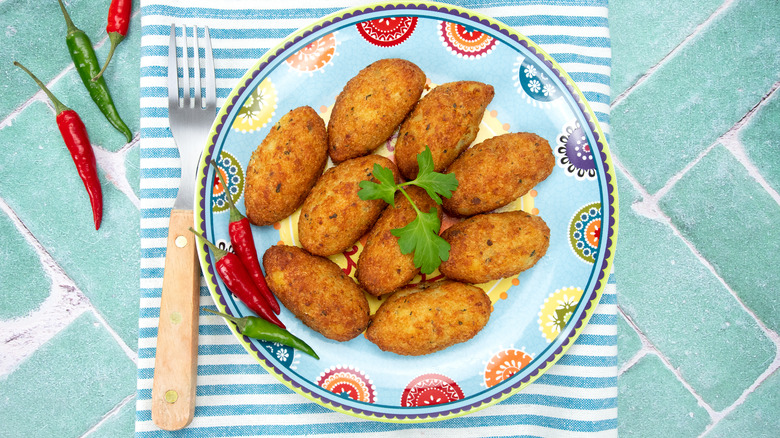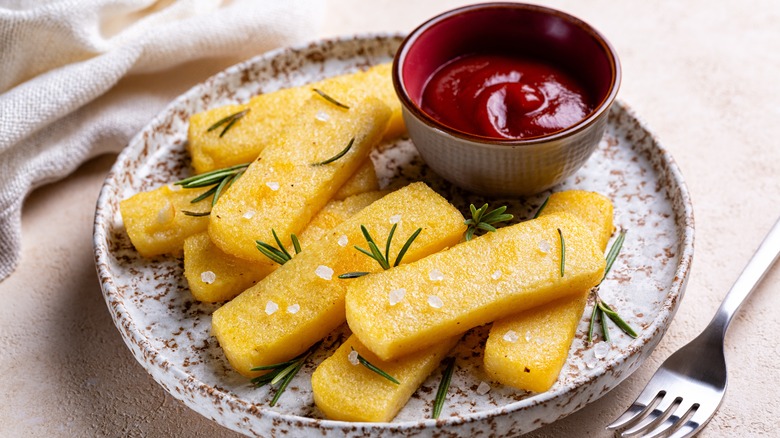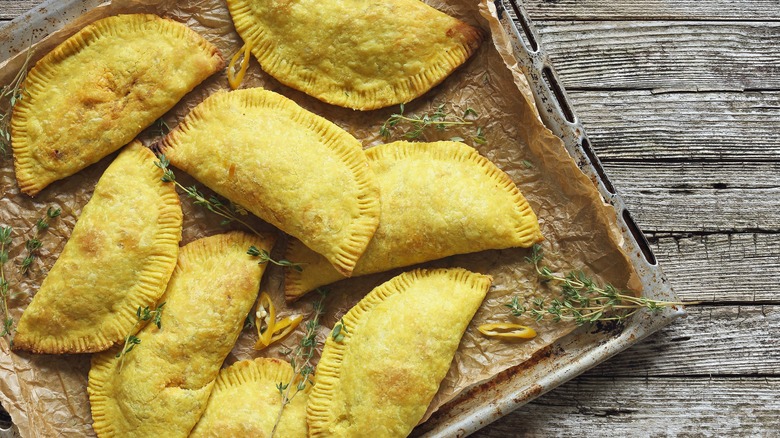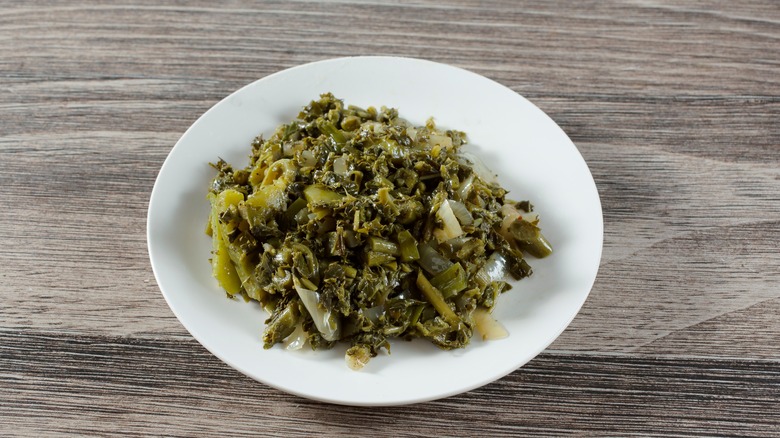15 Caribbean Dishes You Have To Try, According To A Top Chef Guest Judge
Vacation mode is in full swing as sunseekers aim to squeeze every last ounce of sunshine out of the remaining summer months, and nowhere satisfies that craving for tropical out-of-office vibes quite like the Caribbean. Soft white sands, sea breezes, and tiki tipples are all major draws, but the real highlight of a Caribbean escape just might be the food.
From Cuba to Curaçao, every island in the Caribbean Sea has its own distinct flavor. To get a better feel for the region's variety of culinary vibes, we sought out the expertise of chef Helmi Smeulders, a talented Curaçao-based toque with two cookbooks and a successful culinary events business under her belt — not to mention a recent special appearance as a guest judge on the Season 21 semi-final of "Top Chef." She's spent the last two decades traveling, cooking, and eating throughout the Caribbean and has developed a taste for tropical cooking.
"Let me start by saying that there's not one Caribbean cuisine," says Smeulders. "We have all these islands with different histories and influences — so every island has its own staple dishes made with typical ingredients from the region." When it comes to dipping your toes into the wide world of Caribbean flavors, it's easy to find yourself in deep water. Luckily, chef Smeulders is offering a lifeline with these top Caribbean dishes you should try on your next tropical escape.
1. Kabritu stobá
Despite steamy year-round temperatures, stew is a hugely popular dish across the Caribbean region. On the Dutch Caribbean islands of Aruba, Bonaire, and Curaçao (also known as the ABC islands), the dish is best known by its Dutch name, stobá. Among the most popular variations, kabritu stobá is a tomato-based goat stew simmered with fragrant spices until it falls off the bone. While not as widely eaten in the U.S., goat is actually among the world's most popular protein choices — one bite of homemade kabritu stobá, and you might just understand why.
Of course, there's a historical precedent for eating steaming bowls of meaty soup in tropical temperatures. Explaining that enslaved people were typically given the leftover parts of an animal, such as the head, ears, tail, or feet, chef Helmi Smeulders says, "Stewing them was an effective way to use these tougher cuts of meat and make them edible."
Whether you opt for goat water in Montserrat or curried goat in Jamaica, a bowl of slowly simmered goat stew is among the most quintessential Caribbean dishes you have to try. Not a fan of goat? Not a problem. You can find just about any type of stobá on the ABC islands, from chicken and beef to cucumber and papaya.
2. Keshi yená
Another specialty of the ABC islands, keshi yená is a prime example of fusion cuisine. Meaning "stuffed cheese" in Papiamento (Curaçao's local dialect), the dish makes the most of leftover Dutch cheese rinds by transforming them into a Caribbean-tinged delicacy. Chef Helmi Smeulders tells us, "This dish traditionally uses hollowed out leftover cheese rind, often Edam or Gouda, filled with a mixture of shredded chicken, minced meat, or seafood, combined with dried prunes, capers, olives, and spices."
The resulting dumpling is baked until the cheese becomes a gooey case around the mouthwatering mixture — kind of like a cheese-encased pie. The blend of savory and sweet flavors, along with the rich, melty cheese, creates a unique and mouthwatering dish that highlights the ingenuity and resourcefulness of Caribbean cooking. While you'll likely find modern renditions of keshi yená served in ramekins like a cheesy crème brulée, more traditional spots will still serve their version the traditional way: Baked in an empty sausage can or wrapped in plantain leaves.
3. Bake and shark
The name may not be intuitive, but bake and shark is among the most popular street foods in the twin islands of Trinidad and Tobago. "I think this is my favorite Caribbean street food," says chef Helmi Smeulders. "Bake and shark is especially popular at beachside stalls, of which the most famous can be found at Maracas Beach in Trinidad."
In essence, bake and shark is a simple fried fish sandwich, albeit with a very specific Caribbean twist. The bread (or "bake") is soft, slightly sweet fried dough that puffs when cooked to produce a pocket that's perfect for stuffing — not unlike a Caribbean take on pita bread. The fish portion of the sandwich (or "shark") is traditionally a piece of filleted blacktip shark that's been marinated, seasoned, and fried until crispy on the outside and tender on the inside. If eating shark doesn't sit right with you, you can always ask for another flaky white fish substitute. Many stalls sell versions of bake and shark that contain no shark at all, but rather tilapia, skate, or catfish.
The best part about eating bake and shark is the choose-your-own-adventure aspect. Once you've been handed your sandwich, you're free to indulge in the accompanying toppings bar, often outfitted with fresh produce like lettuce, tomato, and coleslaw, as well as local condiments, including chadon beni sauce, garlic sauce, and tamarind sauce.
4. Johnny cakes
No visit to the Caribbean is complete without sampling at least one Johnny cake. Perhaps the most quintessential of Caribbean carbs, the simple fried flatbread made with flour, sugar, baking powder, butter, and water can be found on nearly every island in the tropical region. While you may have heard of Johnny cakes stateside, the American version is a very different animal that is more akin to a cornmeal pancake than the sweet fried flatbread found in Caribbean cooking.
Because the bread is fried, Johnny cakes develop a crisp outside and soft inside, making them the perfect vehicle for sandwiches. "It's typically split open to create a pocket for the filling," says chef Helmi Smeulders. "... On Curaçao, it's a typical Sunday snack stuffed with cheese." Thanks to its mild flavor, Johnny cakes are a versatile dish, enjoyed as a breakfast staple, as a sidekick to stews, or as a satisfying snack. No matter which Caribbean island you visit, there will be no shortage of street food stalls and quick-service eateries serving up hot and fresh Johnny cakes. Be sure to grab a few en route to the beach to enjoy a midday treat like a local.
5. Jerk
Perhaps the most famous of Jamaica's national dishes, jerk is a fiercely protected culinary tradition that has to be done right if it's to be worthy of the name. "The jerk marinade typically includes allspice (pimento), Scotch bonnet peppers, thyme, garlic, and other herbs and spices," says chef Helmi Smeulders. "... I love balancing the vibrant flavors of the jerk with a sweet mango sauce."
The history of jerk is a long and storied one, developing out of the blended traditions of Jamaica's native Taíno people and escaped enslaved Africans. While recipes have evolved over the years, jerk must contain two key elements to be considered the real deal: A spice-heavy marinade and a low-and-slow roast in a smokeless pit. The latter is arguably the more important aspect for an authentic jerk — the smokeless cooking method helped ensure that the free peoples hiding in the mountains couldn't be found and captured by colonial forces.
6. Sòpi mondongo
Tripe: Don't knock it until you try it, especially in a classic soup from Curaçao known as sòpi mondongo. "This hearty soup is known for its rich and flavorful broth," says Helmi Smeulders, "which is typically served with vegetables such as carrots, potatoes, celery, bell peppers, onions, and corn, along with a variety of spices and herbs like garlic, cilantro, and cumin."
As with other Caribbean stews, sòpi mondongo is a dish born out of a need to turn less desirable cuts of meat into something palatable. The hard-working stomach lining of a cow, for example, honeycomb-textured beef tripe is a common organ used in this classic Caribbean stew since it was inexpensive and often disregarded by butchers as unusable. Enterprising cooks discovered that the nutritious meat (packed with protein and essential nutrients like iron and calcium) could be made perfectly palatable when simmered low and slow for several hours, breaking down those tough muscle fibers and transforming the meat into a tender morsel of meaty goodness.
7. Tostones
Where the American South has its fried green tomatoes, the Caribbean islands have fried green plantains. Unlike the sweet, roasted maduros heavily featured in Cuban cuisine, tostones make use of underripe fruit for a savory snack or side dish simply seasoned with salt. Chef Helmi Smeulders suggests serving the twice-fried treat as a tropical appetizer with a tangy dipping sauce or toppings like guacamole or pico de gallo.
The key to making proper tostones is precision. The green plantains need to be treated almost like potatoes, cut into thick 1-inch slices and fried until just golden brown. Once the desired color is reached, the warm rounds need to be smashed into an even round using either a traditional tostoneras or a regular water glass. The freshly flattened tostones should return to the pan for another dip in the hot oil until crisp edges form. Season liberally with salt while they're still warm before digging in.
8. Sancocho
As we've established, stew is a staple in Caribbean cuisine, especially when it doesn't require an exact recipe. Sancocho is a prime example of a dish built solely on good vibes and leftovers.
Popular in the Dominican Republic and Puerto Rico (among other islands), sancocho is a hearty stew that typically includes a blend of proteins and starches like beef, pork, chicken, yuca, plantains, and corn, according to chef Helmi Smeulders. The exact ingredients vary from family to family (or even from pot to pot), but the method remains steadfastly the same: Slow-cook the stew to develop the rich, complex broth that makes this homestyle dish supremely slurpable. Top with a squeeze of lime and cilantro for an extra dose of freshness.
Thanks to its flexibility, sancocho can be made with just about any combination of fresh ingredients you have on hand. And if you double down on the starch, the vegetarian version can be just as hearty as the original.
9. Mofongo
A melting pot of flavor, mofongo perfectly encapsulates Puerto Rico's past on a plate. The dumpling-like dish, made from unripe plantains, is a popular, albeit labor-intensive one. As chef Helmi Smeulders tells us, "The green plantains are cut into pieces and mashed by hand in a wooden pilón together with chicharrones (crispy pork skin) and fresh garlic." The doughy mixture is then typically formed into a ball or mound and stuffed with roasted meats or topped with a rich broth. While mashing by hand isn't the easiest route, it's this old-school method that gives mofongo its distinctive texture and keeps the dish connected to its multicultural roots.
It's widely believed that mofongo has West African origins, with the recipe of a traditional dish called fufu brought over to the Caribbean by enslaved peoples during the Spanish colonial era. This doughy dumpling is typically made using mashed plantains, cassavas, or yams. Since the island's indigenous Taíno population was already using pilón to mash plantains, the culinary integration was nearly seamless. Spanish flavors like chicharrones and camarones guisadas (a red shrimp sauce that is classically paired with mofongo) were later added to the mix, giving the resulting dish a distinctly Puerto Rican flair.
10. Chow
You can't visit the Caribbean without snacking on super-fresh tropical fruit. While the prime produce is delightful on its own, islands like Trinidad and Tobago like to spice it up with a unique street food called chow. "I love the bold flavors of chow," says chef Helmi Smeulders. "It's made by marinating unripe papaya or mango in a mixture of lime juice, salt, chili, garlic, and culantro for a staple Trini street food."
Like a spicy fruit salad, chow is a refreshing blend of sweet fruit, sour citrus, hot chilis, and savory herbs that makes it easy to squeeze in your daily dose of vitamin C. Some spice lovers will add super-hot peppers into the mix, but there's a method to the madness. The capsaicin from the hot peppers can cause you to sweat, instantly cooling your skin beneath the steamy Caribbean sun. So instead of shrinking back from the spice, add an extra serving of hot chili to your chow to enjoy as you stroll along the beach.
11. Doubles
Every country has its tried-and-true hangover cure, and Trinidad is no exception. Typically eaten for breakfast, doubles is a carb-heavy snack that should soak up just about anything left in your stomach from the night before. "Doubles is a beloved street food from Trinidad and Tobago, consisting of two pieces of soft, fried flatbread called bara, filled with curried channa (chickpeas)," chef Helmi Smeulders says. "It's often garnished with tamarind sauce, chili sauce, and other chutneys."
Influenced by Trinidad's heavy Indian population, doubles is essentially a Caribbean twist on chana bhatura, a Northern Indian dish of chana masala and bhatura or puri fried breads. Culinary legend has it that a local couple invented the Trinidadian version of chana bhatura at their cafe in Princes Town in 1936. Hungry customers ordering the restaurant's signature dish of curried chickpeas over flatbread asked to double the flatbread portion of the order. Thus, the term "doubles" was born, and so was a national obsession. You'll want to rise early to snag an order of doubles — the best street vendors are known to sell out long before noon.
12. Accra
Lounging on the beach with a basket of fish fritters is the very picture of an Instagram-worthy vacation moment. Nearly every Caribbean island has its own version of fried seafood, but Trinidad and Tobago's accra saltfish fritters are among some of the most popular. According to chef Helmi Smeulders, the key to Trinidad and Tobago's version is the flavorful seasoning combination used in the batter. "Accra are made by mixing salted cod with a batter of flour, water, fresh herbs such as parsley and scallions, and spices like black pepper and paprika," she says.
While an immensely popular street food on the twin islands, saltfish fritters can be found throughout the Caribbean under various pseudonyms. In Jamaica, they're known as stamp and go, Puerto Rico makes a version called bacalaitos, and Guadeloupe and Martinique's fried fish fritters are known as acras de morue. Each recipe has its own twist, but the main ingredient is always saltfish. Rather than a specific type of fish, the term "saltfish" simply refers to firm white fish (like cod, pollock, or snapper) that has been preserved with salt — a remnant of colonial-era trade that has been transformed into a uniquely Caribbean staple.
13. Funchi hasa
A personal favorite of chef Helmi Smeulders, funchi hasa is essentially Curaçao's twist on french fries. Made from wedges of firm, deep-fried polenta, funchi hasa (or funchi fries, as they're also known) are a perfect side dish on their own, but can also be served sprinkled with cheese or topped with slow-roasted meat, like an island-inspired plate of chili fries.
Like french fries, funchi hasa are easy to eat but not so simple to make. The cornmeal requires constant attention and must be stirred vigorously while cooking in order to achieve the smooth consistency needed for the final product. Once it's reached a thick, porridge-like consistency, according to chef Smeulders, it needs to be cooled until firm so that it can be sliced into logs and fried until crispy on the outside and creamy on the inside. As if you need another reason to love these little deep-fried bites of island goodness, they're also vegan and gluten-free, making them an easily shareable side.
14. Pates
Handheld street foods are popular across the Caribbean for their versatility, portability, and wallet-friendly price points. Case in point: the humble hand pie. Known as pates in the U.S. Virgin Islands, these savory fried pies stuffed with spiced ground beef, chicken, saltfish, or vegetables can be found on just about every island from Bermuda to Bonaire. "In Jamaica, they are known as patties; in Trinidad and Tobago, they are called pies or patties; in Haiti, they are referred to as pâtés; in the Dominican Republic, they are known as pastelitos; and on the ABC islands ... they are known as pastechi," explains chef Helmi Smeulders.
While the highly spiced filling is a hallmark of any variation on the fried hand pie, the key to the perfect pate, patty, or pastelito is the dough. Whether it's flavored with pepper or colored with turmeric, the pastry case should be light, flakey, golden brown, and never, ever oily.
15. Callaloo
Like collard greens in the American South, callaloo is a classic Caribbean veggie dish that transforms fibrous greens into something succulent and hearty. "It is a staple in several Caribbean islands, including Trinidad and Tobago, Jamaica, Grenada, and Dominica, each with its own unique flavorings," says chef Helmi Smeulders.
Made from the leaves of the amaranth, dasheen, or taro plant, callaloo gets its unique depth of flavor from a slow simmer with aromatic ingredients like onions, garlic, and thyme, sometimes with the addition of coconut milk or crab meat. If you're attempting to make callaloo at home, finding the correct combination of leafy vegetables can prove a challenge. In some recipes, callaloo refers to both the name of the dish and the plant used to make it, while others name specific leafy greens. Either way, these tropical plants can be difficult to come by stateside, and many recipes will suggest using a blend of spinach and collard greens to achieve a similar texture. Just be sure to order a traditional bowl of callaloo during your next visit to a Caribbean paradise.

